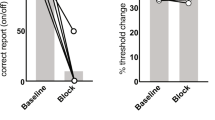Abstract
If a sphygmomanometer cuff is inflated at a pressure above systolic blood pressure on a human limb, a progressive loss of cutaneous sensibility occurs peripheral to the cuff. The work of Lewis, Pickerir and Rothschild1 in this connexion has been repeated and amplified. These authors describe a regularly ascending ‘centripetal paralysis’, and attribute this mode of spread to an increasing susceptibility of individual nerve fibres to the effects of pressure as they are traced proximally from the periphery. We have been unable to confirm any such regular centripetal spread of sensory loss. It has been found that, in the territory of any given nerve, loss of sensibility commences in different sites, not only in different subjects, but also in repeated experiments in the same subject, and spreads irregularly rather than centripetally. Indeed, in several instances an almost regular centrifugal spread has been observed.
Similar content being viewed by others
References
Lewis, T., Pickering, G. W., and Rothschild, P., Heart, 16, 1 (1931).
Weddell, G., and Sinclair, D. C., J. Neurol, Neurosurg. and Psychiat., in the press.
Author information
Authors and Affiliations
Rights and permissions
About this article
Cite this article
WEDDELL, G., SINCLAIR, D. & FEINDEL, W. Significance of Multiple Innervation of Cutaneous Pain ‘Spots’ in Relation to the Quality of Pain Sensibility. Nature 160, 27–28 (1947). https://doi.org/10.1038/160027b0
Issue Date:
DOI: https://doi.org/10.1038/160027b0
- Springer Nature Limited
This article is cited by
-
Population coding of somatic sensations
Neuroscience Bulletin (2012)





